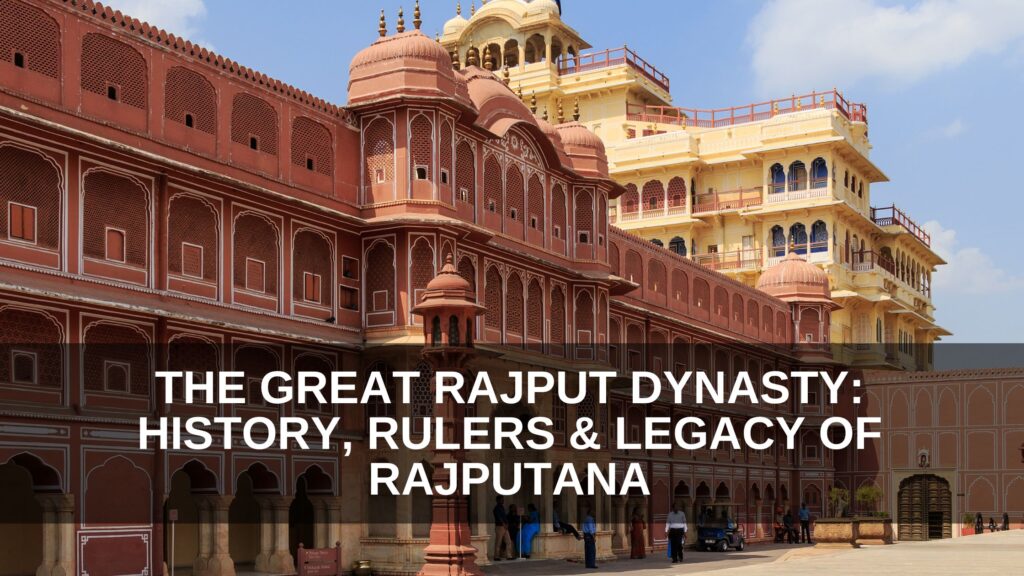After the fall of the Gurjar-Pratihara Empire, several Rajput states emerged in North India. These states played a crucial role in shaping medieval Indian history. The most significant Rajput dynasty were the Paramaras of Malwa, the Chandellas in Bundelkhand, the Chaulukyas (Solankis) of Gujarat, the Chauhans of Ajmer, and the Gahadavalas of Kannauj.
Other smaller dynasties also flourished, such as the Kalachuris of Tripuri, the Loharas of Kashmir, the Tomars of Delhi, and the Kachchhapaghats of Gwalior.
The Ghaznavids and Their Invasions
Mahmud of Ghazni (998-1030 CE) was a prominent ruler who expanded the Ghaznavid Empire by incorporating large parts of Persian and Central Asian territories. He conducted multiple raids into India, mainly to plunder wealth and establish his dominance.
Download notes of Chola Dynasty: History, Achievements
Major Expeditions in India
- In 1001 CE, Mahmud defeated Jayapal of the Hindushahis in the Battle of Waihind/Peshawar, devastating Peshawar.
- In 1015 CE, he attempted an invasion of Kashmir but failed due to unfavorable weather conditions.
- In 1018 CE, he plundered Mathura and attacked Kannauj, the wealthiest city of Hindustan.
- In 1025-26 CE, he raided the Somnath temple in Gujarat twice, suffering heavy losses inflicted by Jats.

Fall of the Ghaznavids
- After Mahmud’s death, internal conflicts weakened the empire.
- The Seljuk Turks and Rajput rulers like the Parmaras and Gahadavalas resisted Ghaznavid expansion.
- The Ghurids ultimately overthrew the Ghaznavids in the late 12th century.
The Chandela Dynasty
The Chandellas ruled over Central India (Bundelkhand) from the 10th to the 13th centuries. Their territory was known as Jejakabhukti (modern Bundelkhand), with capitals at Khajuraho, Kalanjara, and Mahoba.
Key Rulers
- Dhanga (950-999 CE) established Chandela sovereignty over Kalinjar and Gwalior.
- Vidyadhar (1003-1035 CE) resisted Mahmud of Ghazni’s invasions and expanded the Chandella kingdom.
- Parmardi (1165-1203 CE) faced attacks from Prithviraj Chauhan and Qutub-ud-din Aibak.
Cultural Contributions
The Chandellas are renowned for their art and architecture, especially the Khajuraho temples, including the famous Kandariya Mahadev Temple.
The Paramaras of Malwa
The Paramaras were originally vassals of the Rashtrakutas but declared independence under Siyaka (940-972 CE). They ruled the Malwa region from Dharanagar.
Key Rulers
- Bhoja (1010-1055 CE) was the most legendary ruler who expanded the kingdom and contributed to literature, philosophy, and temple architecture.
- After Bhoja’s death, the kingdom faced frequent attacks from the Solankis and Kalachuris, leading to its decline.
The Chaulukyas (Solankis) of Gujarat
The Solankis established their rule in Gujarat and Rajasthan between 940-1244 CE. Their capital was Anhilawada (modern Patan).
Key Rulers
- Bhimadeva I (1025 CE) defended against Mahmud of Ghazni’s raid on the Somnath temple.
- Jaisimha Siddharaja (1092-1142 CE) expanded the kingdom and defeated the Parmaras.
- Kumarpala (1143-1172 CE) controlled rebellions and promoted Jainism.
Decline
The dynasty declined due to Ghurid invasions in 1197 CE and internal conflicts, leading to Vaghela rule by the 1240s.
The Tomars of Delhi
The Tomars ruled Delhi and Hansi before being annexed by the Chauhans in the 12th century.
Key Ruler
- Anangpal Tomar (1051-1081 CE) built the Lal Kot fort in Delhi.
The Chauhans (Chahmanas) of Ajmer
Initially feudatories of the Pratiharas, the Chauhans rose to power and established Ajayameru (modern Ajmer) as their capital.
Key Rulers
- Ajayaraja (1110-1135 CE) expanded Chauhan power.
- Prithviraj Chauhan (1177-1192 CE) fought against Muhammad Ghori in the Battles of Tarain (1191 and 1192). He won the first but lost the second, leading to the fall of the Chauhan dynasty.
Decline
Fratricidal conflicts with neighboring Rajputs and the Ghurid invasion in 1192 CE led to the Chauhans’ downfall.
The Gahadavalas of Kannauj
The Gahadavalas ruled from Kannauj over the Gangetic Doab region between 1090-1193 CE.
Key Rulers
- Chandradeva (1089-1103 CE) established Gahadaval power.
- Govind Chandra (1114-1155 CE) expanded the kingdom from Bihar to Delhi.
- Jai Chandra (1170-1193 CE) was defeated and killed by Muhammad Ghori in 1193 CE.
The Ghurids and the Delhi Sultanate
The Ghurids, centered in Ghor (Afghanistan), expanded into India under Muhammad Ghori.
Download notes of Tripartite Struggle
Key Conquests
- Battle of Tarain (1191 & 1192 CE): Defeated Prithviraj Chauhan in the second battle, paving the way for Muslim rule in North India.
- Capture of Kannauj (1193 CE): Defeated the Gahadavalas.
- Establishment of Delhi Sultanate: After Ghori’s death, his slave Qutub-ud-din Aibak laid the foundation of the Delhi Sultanate.
The Rajput dynasties played a significant role in medieval Indian history. While they resisted foreign invasions, internal conflicts and lack of unity ultimately led to their downfall.
However, their legacy endures through their cultural contributions, especially in architecture, literature, and folklore. The forts, temples, and historical accounts from this period continue to be a source of pride and heritage in India.


